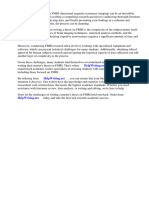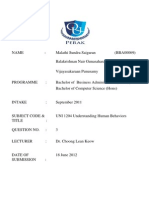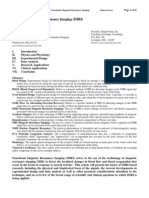F Reading On BITs
F Reading On BITs
Uploaded by
Zahra TejaniCopyright:
Available Formats
F Reading On BITs
F Reading On BITs
Uploaded by
Zahra TejaniOriginal Description:
Original Title
Copyright
Available Formats
Share this document
Did you find this document useful?
Is this content inappropriate?
Copyright:
Available Formats
F Reading On BITs
F Reading On BITs
Uploaded by
Zahra TejaniCopyright:
Available Formats
PET scans (function)
Another example of a functional scanner is the PET scanner. Before a PET scan begins, a
patient is given a safe dose of a radioactive tracer compound and a modified glucose molecule
(FDG). The injected FDG enters the bloodstream, where it can travel to the brain. If a particular
area of the brain is more active, more glucose will be needed there. When more glucose is
used, more radioactive material is absorbed.
The PET scanner measures energy that is emitted when positrons (positively charged particles)
from the radioactive material collide with electrons (negatively charged particles) in the person's
brain. The scan usually takes between 30 minutes and two hours. A computer turns this
information into multicolored, two- or three-dimensional images. The result is a picture showing
which parts of the brain were most active. The color of each dot shows the intensity of the
energy signal. Red indicates the highest intensityin other words, the area of greatest brain
activity.
PET scans provide precise localization of brain activity, which is of great interest to
psychologists studying the correlations between brain activity and cognitive processing
Strengths and limitations of PET Scans
PET can gain information about the brain structure and function of conscious patients who may
be able to perform psychological tasks.
The scans are reliable and provide quantitative as well as qualitative data for the researcher.
The PET scan is very expensive
The PET has relatively poor spatial resolution
It also requires a small amount of radioactive material be injected into the participant. This in
and of itself is not dangerous, but it is still radioactive and is a risk to which the participant would
otherwise not be subjected.
Structural imaging: MRI
The development of several different diagnostic machines which can be used to investigate the
brains structure and activity has revolutionized neuropsychological research. The MRI
(Magnetic Resonance Imaging) gives a three-dimensional picture of the brain structures. MRI
detects changes in blood flow without using a radioactive tracer. It uses magnetic fields and
radio waves. It exploits the fact that some substances that make up the body have intrinsic
magnetic properties and respond to being in a magnetic field, rather as does a compass needle.
When a magnetic field is passed over the head, reverberations are produced by hydrogen
molecules, and these are picked up by the scanner which converts the activity into a structural
image.
Strengths and limitations of MRI Scans
MRIs are non-invasive, unlike the PET scan.
Less expensive than PET and better temporal resolution. This means that the image is taken
several times and then made into a composite image. This composite image is often lacking in
precision and clarity, but is better than the PET scan.
Research is correlational. Causation cannot be established.
fMRI Scans
Unlike the MRI which shows the structure of the brain, the fMRI indicates activity in the brain. In
a sense, it works like a film. The fMRI scanner measures changes in blood flow in the active
brain.
Check out this link to find out more about how it works
https://www.youtube.com/watch?v=nvB9hAarzw4
Strengths and limitations of fMRI Scans
fMRIs are non-invasive, unlike the PET scan
Creates a 3D image of the brain.
Research is correlational. Causation cannot be established.
Critical thinking about brain imaging techniques in general
When discussing brain imaging techniques, there are some overall concerns about their use
that you should consider. You can use these to evaluate whichever technology they apply to.
1. The environment is unnatural and may influence the outcome of the research.
Poldrack (2008) argues that up to 20% of subjects are affected by claustrophobia and refuse to
take part in research in an MRI or fMRI. In addition, obese participants are excluded. This may,
in some cases, lead to sampling bias. In order to make sure that the participant lies still in the
MRI, the tasks which they may be asked to do are very limited and mostly artificial in nature.
2. Colors exaggerate the effects of the brain.
The colors are often misleading, making it look like a specific region of the brain is clearly
defined when in fact the activity of the brain is much more distributed and not as localized as we
would like to believe. In addition, a lot of activity in the brain is spontaneous and not stimulus
driven. We often cannot be sure why there is activity in a part of the brain or what it is doing.
Brain areas activate for many different reasons.
3. Brain images are compilations.
The final image is a statistical compilation of several images taken over the duration of the scan.
It is not an image of the brain at any specific time.
4 Scanning is more ethical and more practical than past data gathering techniques.
In spite of the limitations listed above, brain scanning has been a major help to our
understanding of how the brain works, as well as helping to diagnose people with everything
from Alzheimer's to schizophrenia. Research is much more ethical than the early research as
the techniques are non-invasive. In addition, they are incredibly practical. A team of researchers
around the world can easily discuss an MRI scan by sending it as an email attachment! This
allows for researcher triangulation in the analysis of the data and may lead to a higher validity of
the conclusions reached.
If you want more information to read, you can also check page 44-45 in your course textbook
You might also like
- RN Ati Pediatric Nursing 2023 Exam (70 NGN Questions With Answers)Document15 pagesRN Ati Pediatric Nursing 2023 Exam (70 NGN Questions With Answers)Allstudy67% (3)
- ADULT HEALTH NURSING-2 INCLUDING GERIATRIC NURSING (Syllabus)Document4 pagesADULT HEALTH NURSING-2 INCLUDING GERIATRIC NURSING (Syllabus)Abhishek NaharNo ratings yet
- Models of Tennis FitnessDocument22 pagesModels of Tennis Fitnesstreskavac100% (2)
- Doshas & AgniDocument9 pagesDoshas & AgniDarshAna PaulaNo ratings yet
- Brain Scanning TechniquesDocument5 pagesBrain Scanning Techniquesmallika20043No ratings yet
- Discuss The Use of Brain Imaging Technology Investigating The Relationship Between Biological Factors and BehaviorDocument2 pagesDiscuss The Use of Brain Imaging Technology Investigating The Relationship Between Biological Factors and Behaviorvicomanga100% (1)
- The Research Methods of BiopsychologyDocument2 pagesThe Research Methods of BiopsychologyJanice PilapilNo ratings yet
- Neurological ExamiinationDocument28 pagesNeurological ExamiinationLata aryaNo ratings yet
- Biological Erq-2Document21 pagesBiological Erq-2udayanrawal31No ratings yet
- COGNITIVEDocument10 pagesCOGNITIVENivedita MenonNo ratings yet
- Brain Mapping and Its Contribution To The Advancement of Neuro TechnologyDocument7 pagesBrain Mapping and Its Contribution To The Advancement of Neuro TechnologySaarvariNo ratings yet
- Brain MappingDocument8 pagesBrain MappingRoman Mamun100% (1)
- Techno-Post Galleria: AbstractDocument5 pagesTechno-Post Galleria: AbstractAfshan ManzoorNo ratings yet
- Law and Emerging Technology PsdaDocument10 pagesLaw and Emerging Technology PsdaManan GuptaNo ratings yet
- Brain Scanning TechniquesDocument14 pagesBrain Scanning TechniquesM Effendy Nugraha HasibuanNo ratings yet
- Brain Imaging Technologies and Their Applications in NeuroscienceDocument45 pagesBrain Imaging Technologies and Their Applications in NeuroscienceNeea AvrielNo ratings yet
- Bio CIA-1Document6 pagesBio CIA-1OSHMITA BHATTACHARJEE 23223145No ratings yet
- Master Thesis FmriDocument8 pagesMaster Thesis Fmriafknfbdpv100% (1)
- ERQ Paper 1Document27 pagesERQ Paper 1Phương Anh Cao HoàngNo ratings yet
- By: Roslyn Mclaurin Psy/240 Rosa Federico-OchoaDocument8 pagesBy: Roslyn Mclaurin Psy/240 Rosa Federico-OchoaRoslyn MclaurinNo ratings yet
- Mri & Fmri ContrastDocument2 pagesMri & Fmri Contrastreginalopezsalinas11No ratings yet
- NNEWDDDocument8 pagesNNEWDDAmolSuhasVedpathakNo ratings yet
- Cognitive Notes Psy11Document5 pagesCognitive Notes Psy11Navneet DhimanNo ratings yet
- Biological Approach BookletDocument60 pagesBiological Approach BookletSiyao LiuNo ratings yet
- Complete UhbDocument25 pagesComplete UhbMalathi SundrasaigaranNo ratings yet
- Computerized Axial Tomography (CAT)Document5 pagesComputerized Axial Tomography (CAT)natasha singhNo ratings yet
- What Is Molecular ImagingDocument4 pagesWhat Is Molecular ImagingSatish G KulkarniNo ratings yet
- FMRI, MEG, PET, EEG - Descriptions of ProceduresDocument2 pagesFMRI, MEG, PET, EEG - Descriptions of Proceduresjovanb1No ratings yet
- Biological - All SAQ QuestionsDocument10 pagesBiological - All SAQ QuestionsEthan FongNo ratings yet
- Brain MappingDocument14 pagesBrain MappingmayankdhiyaniaNo ratings yet
- 72 191 1 PBDocument6 pages72 191 1 PBDaniel OrdazNo ratings yet
- Unit 1a - Intelligence and NeuroscienceDocument27 pagesUnit 1a - Intelligence and NeuroscienceManjushree RandiveNo ratings yet
- Methods in BiopsychologyDocument28 pagesMethods in Biopsychologydrc.psyNo ratings yet
- Biopsychology Week 3Document3 pagesBiopsychology Week 3yoooonbumNo ratings yet
- MIT Implicit Explicit LearningDocument7 pagesMIT Implicit Explicit Learningmiriam.sanz.salidoNo ratings yet
- PSY115 - Activity 2.1Document1 pagePSY115 - Activity 2.1Darren Daniel InfanteNo ratings yet
- Fmri Master ThesisDocument4 pagesFmri Master ThesisInstantPaperWriterSpringfield100% (2)
- Detecting and Classifying Fetal Brain Abnormalities Using Decision Tree AlgorithmDocument6 pagesDetecting and Classifying Fetal Brain Abnormalities Using Decision Tree AlgorithmAttah FrancisNo ratings yet
- Savoy Functional MRIDocument21 pagesSavoy Functional MRIAlejandra CorkNo ratings yet
- Notes Psych Defs and StudiesDocument8 pagesNotes Psych Defs and StudiesHARSHA LNo ratings yet
- Techniques Used To Study The Brain in RelationDocument9 pagesTechniques Used To Study The Brain in RelationrishNo ratings yet
- Methods of Studying The Brain EssayDocument1 pageMethods of Studying The Brain EssayHala AbdullahNo ratings yet
- PET ScanDocument3 pagesPET ScanChim PalmarioNo ratings yet
- Resonancia Magnética (Inglés/Castellano)Document7 pagesResonancia Magnética (Inglés/Castellano)José Jiménez TomasinoNo ratings yet
- Evaluate Techniques Used To Study The Brain in Relation To Human Behavior.Document3 pagesEvaluate Techniques Used To Study The Brain in Relation To Human Behavior.Ashley LauNo ratings yet
- Prabhsharn cl21m012Document12 pagesPrabhsharn cl21m012prabhsharn SinghNo ratings yet
- PSYC 2410 DE S12 Textbook Notes Chapter 05 PDFDocument17 pagesPSYC 2410 DE S12 Textbook Notes Chapter 05 PDFKatarina GruborovićNo ratings yet
- EssayDocument2 pagesEssaygayane.sushinskayaNo ratings yet
- Explain one technique used to study the brain in relation to behavior with reference to one study. 2Document1 pageExplain one technique used to study the brain in relation to behavior with reference to one study. 2Nitya RamchandaniNo ratings yet
- A Spect ScanDocument1 pageA Spect ScanAisy NahdahNo ratings yet
- PsychologyDocument14 pagesPsychologySiti SarahNo ratings yet
- BIOPSYCHOLOGYDocument34 pagesBIOPSYCHOLOGYNeha50% (2)
- Module 3Document3 pagesModule 3nehasri.sagineeduNo ratings yet
- Reporte Electivo DraftDocument9 pagesReporte Electivo DraftJaviera Andrea Cornejo AndradesNo ratings yet
- A Neural Network Based Imaging System For FmriDocument15 pagesA Neural Network Based Imaging System For FmriNT VivekNo ratings yet
- Mapping of The BrainDocument2 pagesMapping of The BrainVictor HauerslevNo ratings yet
- Neuro ImagingDocument48 pagesNeuro ImagingSeiska MegaNo ratings yet
- Detailed Plan ERQDocument3 pagesDetailed Plan ERQThalia VladimirouNo ratings yet
- Slide 7 - PETDocument11 pagesSlide 7 - PETMr RobotNo ratings yet
- Math268 FmriDocument4 pagesMath268 FmriMichael Angelo Laguna Dela FuenteNo ratings yet
- Imaging TechDocument1 pageImaging TechSupreet BhaskarNo ratings yet
- Hybrid Model Implementation For Brain Tumor Detection System Using Deep Neural NetworksDocument8 pagesHybrid Model Implementation For Brain Tumor Detection System Using Deep Neural NetworksIJRASETPublicationsNo ratings yet
- F Brain Imaging NotesDocument15 pagesF Brain Imaging NotesZahra TejaniNo ratings yet
- FOA Planning: Specifically, I Will Use The Following Texts or Genres For StudyDocument1 pageFOA Planning: Specifically, I Will Use The Following Texts or Genres For StudyZahra TejaniNo ratings yet
- F Brain Imaging NotesDocument15 pagesF Brain Imaging NotesZahra TejaniNo ratings yet
- Monday, 10 April 2017: Timeline 2017 Date ContentDocument1 pageMonday, 10 April 2017: Timeline 2017 Date ContentZahra TejaniNo ratings yet
- NAME: Paper 1 AB Initio G11: Summative AssessmentDocument2 pagesNAME: Paper 1 AB Initio G11: Summative AssessmentZahra TejaniNo ratings yet
- Brown and Kulik (1977)Document3 pagesBrown and Kulik (1977)Zahra TejaniNo ratings yet
- 2013 Edition Theory of Knowledge Course Companion-Dombrowski, Rotenberg & BickDocument15 pages2013 Edition Theory of Knowledge Course Companion-Dombrowski, Rotenberg & BickZahra TejaniNo ratings yet
- International School of Tanganyika: Insurance and Medical DetailsDocument3 pagesInternational School of Tanganyika: Insurance and Medical DetailsZahra TejaniNo ratings yet
- KjktdytufyghjklDocument1 pageKjktdytufyghjklZahra TejaniNo ratings yet
- Biological Level of Analysis Charts Localization of FunctionDocument2 pagesBiological Level of Analysis Charts Localization of FunctionZahra TejaniNo ratings yet
- Unit 4 Workbook: IB EconomicsDocument36 pagesUnit 4 Workbook: IB EconomicsZahra TejaniNo ratings yet
- IST Event Planner Form: RequiredDocument4 pagesIST Event Planner Form: RequiredZahra TejaniNo ratings yet
- Biological Level of Analysis Charts Localization of FunctionDocument2 pagesBiological Level of Analysis Charts Localization of FunctionZahra TejaniNo ratings yet
- Moshi 2016 Parent Letter 1Document3 pagesMoshi 2016 Parent Letter 1Zahra TejaniNo ratings yet
- Categorizing Knowledge NEW CompanionDocument15 pagesCategorizing Knowledge NEW CompanionZahra TejaniNo ratings yet
- Monitor G3 Manual Service V0 1 PDFDocument156 pagesMonitor G3 Manual Service V0 1 PDFVinicius Belchior da SilvaNo ratings yet
- Sexual Dysfunction in Patients With Spinal Cord Lesions: Furlan Et Al., 2013Document21 pagesSexual Dysfunction in Patients With Spinal Cord Lesions: Furlan Et Al., 2013Đỗ Văn ĐứcNo ratings yet
- Ugaoo - Com - Agri Startup - Apoorva SharmaDocument8 pagesUgaoo - Com - Agri Startup - Apoorva SharmaShubham PatelNo ratings yet
- Amiya Kumar Das - Grassroots Democracy and Governance in India - Understanding Power, Sociality and Trust-Springer Singapore (2022)Document189 pagesAmiya Kumar Das - Grassroots Democracy and Governance in India - Understanding Power, Sociality and Trust-Springer Singapore (2022)K RajNo ratings yet
- Central Medical Gas System: C. S. DudgikarDocument25 pagesCentral Medical Gas System: C. S. DudgikarChidambar DudgikarNo ratings yet
- 37588-12378557 MsdsDocument4 pages37588-12378557 MsdsmisterpokeNo ratings yet
- Shoulder Impingement Non Surgical ProtcolDocument3 pagesShoulder Impingement Non Surgical Protcolmchen5840No ratings yet
- Salivary Gland Disorders - AHNDocument42 pagesSalivary Gland Disorders - AHNZimran SalimNo ratings yet
- Genetically Modified Organism (GMO)Document73 pagesGenetically Modified Organism (GMO)Joshua G. JavierNo ratings yet
- 4 Types of GroupsDocument23 pages4 Types of GroupsNurfarah WahidahNo ratings yet
- SSRI For Sex OffendersDocument72 pagesSSRI For Sex OffendersnanaNo ratings yet
- Manual Mitsubishi Drive MRJ-3Document40 pagesManual Mitsubishi Drive MRJ-3Jorge MorenoNo ratings yet
- Calcium Cyanide: Hydrogen Cyanide. CONSULT THE NEW JERSEYDocument6 pagesCalcium Cyanide: Hydrogen Cyanide. CONSULT THE NEW JERSEYbacabacabacaNo ratings yet
- Future DirectionsDocument5 pagesFuture DirectionsMark ElbenNo ratings yet
- The HRC Test BrochureDocument4 pagesThe HRC Test BrochureMahendra NaharNo ratings yet
- Child and Adolescent Development MultiplDocument13 pagesChild and Adolescent Development MultiplHannah Coleen AndradaNo ratings yet
- Cortisol GuideDocument4 pagesCortisol Guidemepaniumang56No ratings yet
- Nestle Case Study (Abhinav Bhushan)Document5 pagesNestle Case Study (Abhinav Bhushan)neil926No ratings yet
- Epidemiological Literature ReviewDocument8 pagesEpidemiological Literature Reviewafmzbzdvuzfhlh100% (1)
- Case Study 1Document23 pagesCase Study 1falguni mondalNo ratings yet
- International Journal of Pharmaceutics: Shuai Qian, Yin Cheong Wong, Zhong ZuoDocument11 pagesInternational Journal of Pharmaceutics: Shuai Qian, Yin Cheong Wong, Zhong ZuomoazrilNo ratings yet
- Derangements of Potassium - Emergency Medicine 2014Document19 pagesDerangements of Potassium - Emergency Medicine 2014Michael AmarilloNo ratings yet
- Casilan, Ynalie Drug Study (Morphine)Document5 pagesCasilan, Ynalie Drug Study (Morphine)Ynalie CasilanNo ratings yet
- WRC Profile Completed 25-01-2019Document41 pagesWRC Profile Completed 25-01-2019TARIQNo ratings yet
- Battery MSDSDocument3 pagesBattery MSDSAnkitNo ratings yet
- Review of The Ch. Karnchang Public Company Limited Environmental Impact Assessment (Xayaburi Dam) byDocument9 pagesReview of The Ch. Karnchang Public Company Limited Environmental Impact Assessment (Xayaburi Dam) bySavetheMekongNo ratings yet






































































































